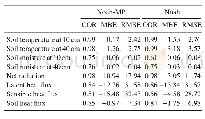《Table 1.Average steel composition and temperature at the end of the RH refinement process》
 提示:宽带有限、当前游客访问压缩模式
提示:宽带有限、当前游客访问压缩模式
本系列图表出处文件名:随高清版一同展现
《Novel mechanism for the modification of Al_2O_3-based inclusions in ultra-low carbon Al-killed steel considering the effects of magnesium and calcium》
Note:a[O]is oxygen activity of oxygen in liquid steel.
Industrial trials were conducted on ultra-low-carbon Al-killed steel coil in a 120-t ladle in a steel plant in China.Two routes were performed to evaluate the different behaviors of inclusions with different Ca and Mg contents during the secondary refining process.The first route(Type A)followed the sequences of basic oxygen furnace(BOF)–ladle furnace(LF)–Ruhrstahl-Hereaeus(RH)–continuous casting(CC),whereas the second route(Type B)followed the sequences of BOF–RH–CC.The main difference between the two routes is that Ca treatment was performed at the end of the RH refinement process in the first route,whereas Ca treatment was not performed in the second route.Correspondingly,liquid steel treated through the first route had higher Ca(20–50 ppm)and Mg(10–20 ppm)contents,whereas that treated through the second route had considerably lower Ca and Mg contents,as shown in Table 1.Table2 lists the slag composition,which was computed as the average of five heats,at the end of the two RH refinings.Highly basic refined slags were used in the two secondary refining routes.However,the slag used for the second route had lower basicity and higher oxidizing component(Fe O+Mn O)content.Steel samples were taken out after calcium wire feeding at the end of the RH refinement process(approximately five minutes after Ca treatment),as well as in the tundish.The activities of dissolved oxygen in liquid steel and steel temperatures were measured with an oxygen probe and a sensor.Steel and slag samples were then prepared for chemical analysis.The composition of the steel samples was analyzed through inductively coupled plasma–atomic emission spectrometry and with a carbon/sulfur analyzer.The slag composition was analyzed using an X-ray fluorescence spectrometer.The morphology,size,and composition of inclusions in cross-sectioned steel samples were detected and analyzed through scanning electron microscopy(SEM)and energy dispersive spectroscopy(EDS).Each route was measured five times.Approximately 20 inclusions were examined in accordance with a designed direction per sample.Fact Sage 6.4 was employed to calculate the component activities in liquid inclusions for thermodynamic analysis.
| 图表编号 | XD002863300 严禁用于非法目的 |
|---|---|
| 绘制时间 | 2018.03.01 |
| 作者 | Jing Guo、Shu-sen Cheng、Han-jie Guo、Ya-guang Mei |
| 绘制单位 | School of Metallurgical and Ecological Engineering, University of Science and Technology Beijing、Beijing Key Laboratory of Special Melting and Reparation of High-end Metal Materials, University of Science and Technology Beijing、School of Metallurgical and |
| 更多格式 | 高清、无水印(增值服务) |
查看“Table 1.Average steel composition and temperature at the end of the RH refinement process”的人还看了
-

- 表3 长白山西坡不同海拔暖季开始和结束日期Table 3The beginning and ending dates of w arm season at various altitudes on the w estern slope of





